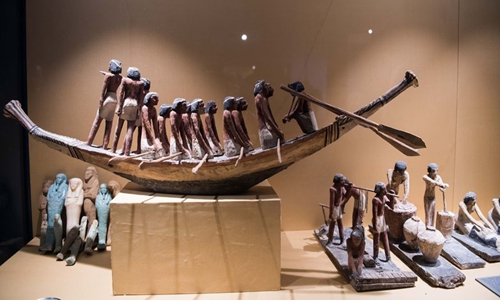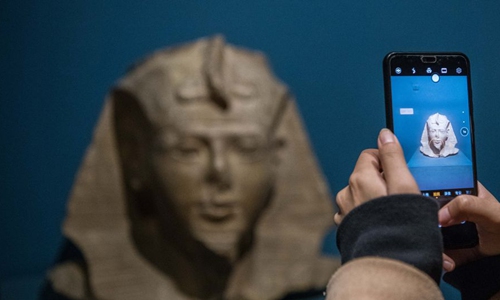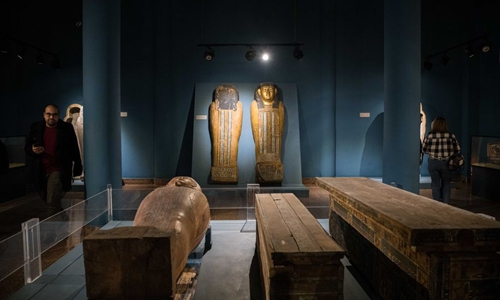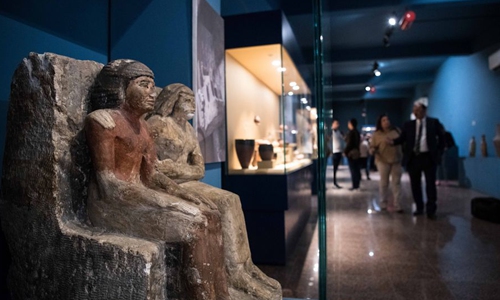HOME >> ARTS
Upper Egypt's Mallawi Museum restores popularity years after looting
Source:Xinhua Published: 2020/2/9 11:12:44

Photo taken on Jan. 30, 2020, shows artifacts in Mallawi Museum, Minya province, Egypt. (Xinhua/Wu Huiwo)
Mallawi Museum in Upper Egypt's province of Minya has gained more popularity every year since it was reopened in late 2016, three years after its looting during riots in the monument-rich country.
Gathering artifacts dating back to different ages of the Egyptian civilization including Pharaonic, Greco-Roman, Coptic and Islamic objects, the museum was first opened in July 1963, looted in August 2013, and reopened in September 2016 with more attractive interior and exhibition halls.
"The museum has now 950 objects. It had 1,089 artifacts before looting, some of which were ruined, some lost and some restored and re-exhibited," Gehan Nassem, director of Mallawi Museum, told Xinhua.
Standing like a sandy beige fortress in the heart of Minya's city of Mallawi, the two-floor museum is built on an area of about 2,500 square meters.
The first floor has three dimly-lit stone blue exhibition halls. Touring them is like taking a U-turn starting from the gate, passing by the first hall, turning to the second and ending the tour at the third.

A visitor takes photos of a statue in Mallawi Museum, Minya province, Egypt, on Jan. 30, 2020. (Xinhua/Wu Huiwo)
The first hall exhibits the daily and family life of ancient Egyptians, including some of their crafts and the tools they used for writing, lighting, hunting, baking and cooking.
Among the rare masterpieces in the first hall are a statue of King Akhenaton's daughter from the New Kingdom of ancient Egypt and a double statue of a man called Ankh Pepi and his wife sitting side by side, dating back to the Old Kingdom some 4,500 years ago, Nassem noted.
The second hall features ancient funerary objects such as colorful and plain anthropoid wooden and alabaster coffins, while the third contains Greco-Roman, Coptic and Islamic objects including mummy masks, pottery statues, paintings, icons, tombstones, coins and others.
"When the museum was reopened, it sent a message of peace to the whole world that Egypt is able to preserve its heritage," said Nassem.
The second floor of the museum, which includes a library, is dedicated to activities such as lectures, workshops and festivities on special occasions and national days.
The Egyptian minister of tourism and antiquities recently visited Mallawi Museum following his announcement of the discovery of more than a dozen tombs with sarcophagi in a nearby necropolis on the outskirts of Mallawi.

People visit Mallawi Museum in Minya province, Egypt, on Jan. 30, 2020. (Xinhua/Wu Huiwo)
"The museum has become more popular and attractive over the past couple of years. We promote the museum and raise awareness about it on social media websites and we cooperate with schools and civil society groups to organize visits to the museum," Osama Talaat, deputy director of the museum, told Xinhua.
He explained that Mallawi Museum arranges visits for students whose history textbook involves eras or objects exhibited in the museum, explaining to them the historical facts in a simplified way such as using tales.
Hossam Fayez, a curator, said they also "focus on showing the local visitors the artifacts related to their crafts, whether they are farmers, bakers, or potters."
At least 80 percent of the artifacts stolen from the museum in 2013 were retrieved and about half of them needed restoration before their current exhibition.
Hany Faried, director of Mallawi's office of the Egyptian tourism promotion authority, said the museum now receives tourist groups of different nationalities every day.
"Mallawi Museum is the only one on the long way between the Egyptian Museum in Cairo in the north and Luxor Museum in Luxor Province in the south," Faried said.

Photo taken on Jan. 30, 2020, shows a double statue of a person called Ankh Pepi and his wife setting side by side, dating back to the Old Kingdom some 4,500 years ago, in Mallawi Museum, Minya province, Egypt. (Xinhua/Wu Huiwo)
Most foreign tourists come to the museum as part of their Nile River cruise tours back and forth between Cairo and the monument-rich southern province of Aswan, he added.
"This is my first visit to the museum and I regret I didn't do it before. It shows us beautiful things about the history of our ancestors," Mahmoud al-Shemi, a 35-year-old engineer, told Xinhua.
"I will definitely recommend Mallawi Meuseum to my relatives and friends," al-Shemi said, accompanied by his wife and three children at the museum.
Posted in: ART,CULTURE & LEISURE